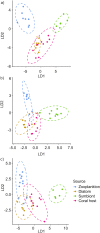Evaluating coral trophic strategies using fatty acid composition and indices
- PMID: 31509600
- PMCID: PMC6739055
- DOI: 10.1371/journal.pone.0222327
Evaluating coral trophic strategies using fatty acid composition and indices
Abstract
The ecological success of shallow water reef-building corals has been linked to the symbiosis between the coral host and its dinoflagellate symbionts (herein 'symbionts'). As mixotrophs, symbiotic corals depend on nutrients 1) transferred from their photosynthetic symbionts (autotrophy) and 2) acquired by host feeding on particulate organic resources (heterotrophy). However, coral species differ in the extent to which they depend on heterotrophy for nutrition and these differences are typically poorly defined. Here, a multi-tracer fatty acid approach was used to evaluate the trophic strategies of three species of common reef-building coral (Galaxea fascicularis, Pachyseris speciosa, and Pocillopora verrucosa) whose trophic strategies had previously been identified using carbon stable isotopes. The composition and various indices of fatty acids were compared to examine the relative contribution of symbiont autotrophy and host heterotrophy in coral energy acquisition. A linear discriminant analysis (LDA) was used to estimate the contribution of polyunsaturated fatty acids (PUFA) derived from various potential sources to the coral hosts. The total fatty acid composition and fatty acid indices revealed differences between the more heterotrophic (P. verrucosa) and more autotrophic (P. speciosa) coral hosts, with the coral host G. fascicularis showing overlap with the other two species and greater variability overall. For the more heterotrophic P. verrucosa, the fatty acid indices and LDA results both indicated a greater proportion of copepod-derived fatty acids compared to the other coral species. Overall, the LDA estimated that PUFA derived from particulate resources (e.g., copepods and diatoms) comprised a greater proportion of coral host PUFA in contrast to the lower proportion of symbiont-derived PUFA. These estimates provide insight into the importance of heterotrophy in coral nutrition, especially in productive reef systems. The study supports carbon stable isotope results and demonstrates the utility of fatty acid analyses for exploring the trophic strategies of reef-building corals.
Conflict of interest statement
The authors have declared that no competing interests exist.
Figures





Similar articles
-
Trophic dynamics of scleractinian corals: stable isotope evidence.J Exp Biol. 2015 Apr 15;218(Pt 8):1223-34. doi: 10.1242/jeb.115303. Epub 2015 Feb 26. J Exp Biol. 2015. PMID: 25722004
-
Gradients in Primary Production Predict Trophic Strategies of Mixotrophic Corals across Spatial Scales.Curr Biol. 2018 Nov 5;28(21):3355-3363.e4. doi: 10.1016/j.cub.2018.08.057. Epub 2018 Oct 18. Curr Biol. 2018. PMID: 30344114
-
Symbiodiniaceae Are the First Site of Heterotrophic Nitrogen Assimilation in Reef-Building Corals.mBio. 2022 Oct 26;13(5):e0160122. doi: 10.1128/mbio.01601-22. Epub 2022 Sep 20. mBio. 2022. PMID: 36125280 Free PMC article.
-
[Progress of heterotrophic studies on symbiotic corals].Ying Yong Sheng Tai Xue Bao. 2017 Dec;28(12):4143-4149. doi: 10.13287/j.1001-9332.201712.032. Ying Yong Sheng Tai Xue Bao. 2017. PMID: 29696913 Review. Chinese.
-
Genome Evolution of Coral Reef Symbionts as Intracellular Residents.Trends Ecol Evol. 2019 Sep;34(9):799-806. doi: 10.1016/j.tree.2019.04.010. Epub 2019 May 10. Trends Ecol Evol. 2019. PMID: 31084944 Review.
Cited by
-
Harnessing the Power of Model Organisms To Unravel Microbial Functions in the Coral Holobiont.Microbiol Mol Biol Rev. 2022 Dec 21;86(4):e0005322. doi: 10.1128/mmbr.00053-22. Epub 2022 Oct 26. Microbiol Mol Biol Rev. 2022. PMID: 36287022 Free PMC article. Review.
-
Changes within the coral symbiosis underpin seasonal trophic plasticity in reef corals.ISME Commun. 2025 Mar 14;5(1):ycae162. doi: 10.1093/ismeco/ycae162. eCollection 2025 Jan. ISME Commun. 2025. PMID: 40130204 Free PMC article.
-
Selective nutrient incorporation may underestimate heterotrophy of a mixotrophic reef-building coral.Commun Biol. 2025 Aug 26;8(1):1285. doi: 10.1038/s42003-025-08621-8. Commun Biol. 2025. PMID: 40858878 Free PMC article.
-
Improving Coral Grow-Out Through an Integrated Aquaculture Approach.Aquac Nutr. 2025 Apr 13;2025:1446195. doi: 10.1155/anu/1446195. eCollection 2025. Aquac Nutr. 2025. PMID: 40260154 Free PMC article.
References
-
- Goreau TF, Goreau NI, Yonge CM. Reef corals: autotrophs or heterotrophs? Biol Bull. 1971;141: 247–260. Available: http://www.biolbull.org/content/141/2/247.short
-
- Muscatine L, Porter JW, Kaplan IR. Resource partitioning by reef corals as determined from stable isotope composition: I. d13C of zooxanthellae and animal tissue vs depth. Mar Biol. 1989;100: 185–193. 10.1007/BF00391957 - DOI
Publication types
MeSH terms
Substances
LinkOut - more resources
Full Text Sources
Research Materials

